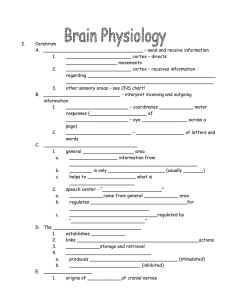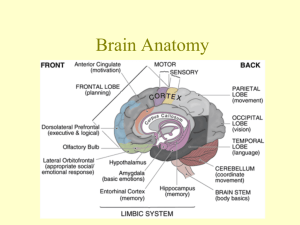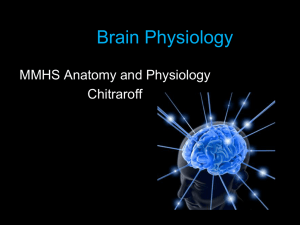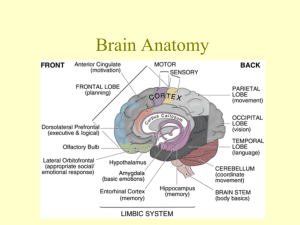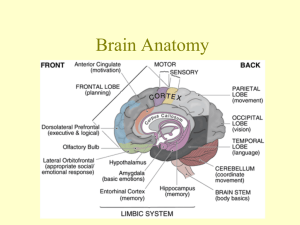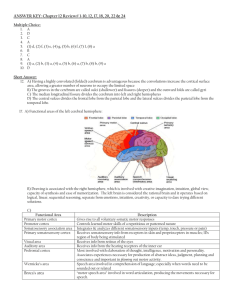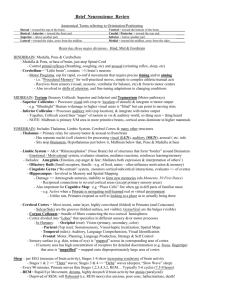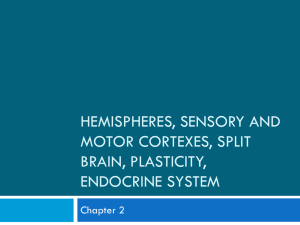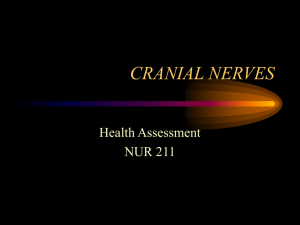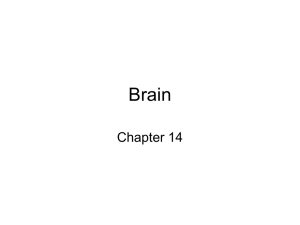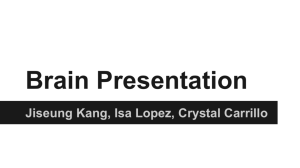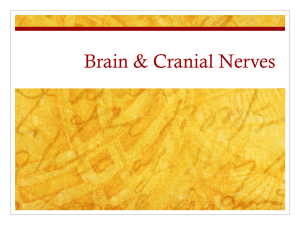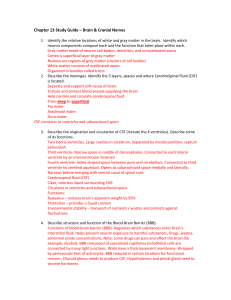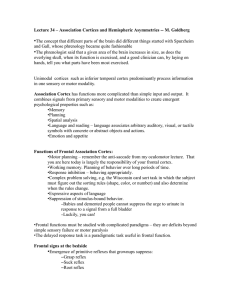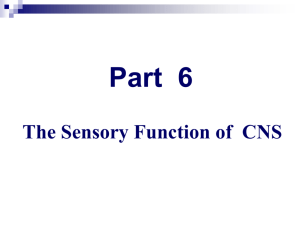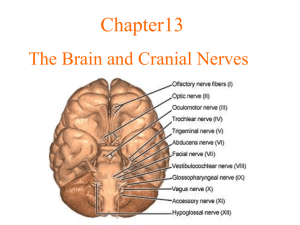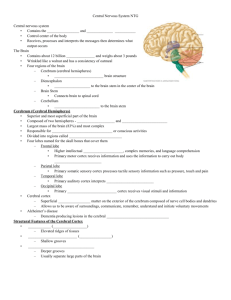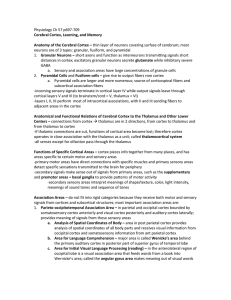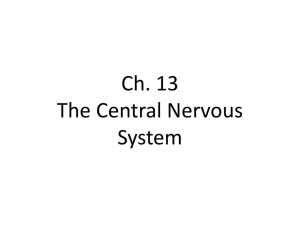Ppt
advertisement
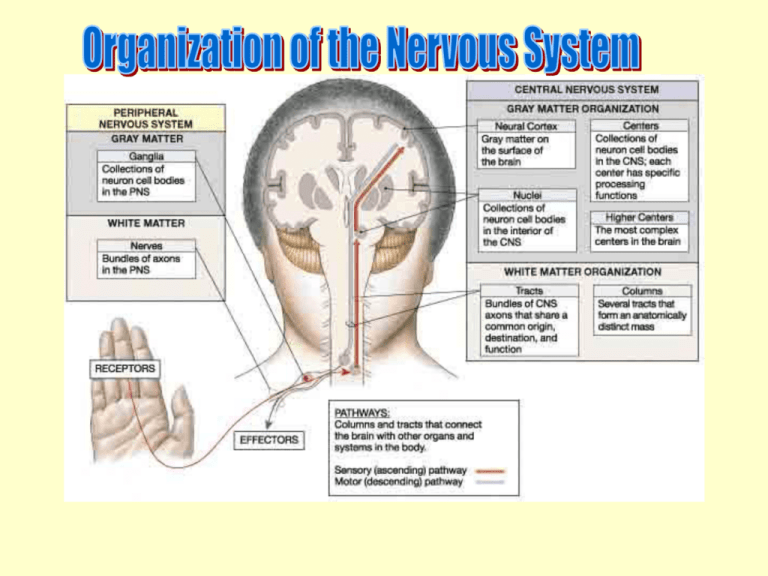
Dura Mater •Superficial •Fuses brain to skull Arachnoid •Reduces friction •Filled with CSF; shock absorber Pia Mater •Very Vascular; needs a lot of oxygen due to high metabolic rate of neurons 1. Cerebrum 2. Diencephalon 3. Midbrain 4. Pons 5. Medulla Oblongata 6. Cerebellum Gyri: elevated ridges Sulci: furrows Bridge between Right and Left Hemispheres •Enables Right and Left sides to communicate with each other Problems “Split Brain” Syndrome Functions: •Cognition and Memory •Prefrontal Area: involved with intellect, complex learning abilities and personality; plays a role in mood •“Gatekeeper” Judgment, critical thinking and reasoning skills Problems Memory loss, inability to concentrate, behavior disorder, Inappropriate social and/or sexual behavior Function: •Motor Strip: Control voluntary motor function •Premotor Cortex: skill area; controls learned motor skills Gyri: elevated ridges Sulci: furrows Broca’s area •Left hemisphere •Directs the muscles of tongue, throat and lips when speaking •Becomes active as we plan to speak •Syntax and grammar rules are remembered Try This!! Yes the bick. I would say tha the vick daysis nosis or chipickers. Represents problems with Broca’s area!! Only found in the left hemisphere of the frontal lobe Problems will affect our ability to pronounce words, speaking becomes a problem Located in parietal, temporal and occipital lobes Primary Somatosensory Cortex •Process sensory input from skin receptors •Proprioceptors in skeletal muscle; body orientation •Spatial Discrimination – ability to identify the body region being stimulated •Try This!! •Gustatory cortex - taste Problems •Inability to locate and recognize body parts; disorientation •Can’t discriminate between different sensory stimuli •Located posterior to Primary Somatosensory Cortex •Major function to analyze different sensory stimuli (temp, pressure •Evaluate what the body is feeling •Try this!! •Different senses are distributed through all lobes •Auditory Areas – sound waves are interpreted •Association area – defines the sound •Olfactory Cortex – interprets chemical odors Language •Wernicke’s area – called the speech area •Language comprehension •Reading unfamiliar sounds Problems •Hearing problems •Aphasia – inability to speak Affective Language Area •Regions involved in the nonverbal, emotional pieces of language •Appears to be present in the hemispheres opposite of Broca’s and Wernicke’s area (Right side mirror image) •Voice tone and gestures express your emotions when you speak Problems Monotone – impairments in this area Hearing and the Temporal Lobe Visual Areas •Receives stimuli from eyes •Interprets information from past experiences Problems Loss of vision or “seeing stars” Can’t recognize the object you see Left Hemisphere 90% is dominant for Language abilities, logic and math skills Right Hemisphere 90% is involved in visualspatial skills, emotion, music,poetry, & creativity Connects to cerebrum Includes thalamus, hypothalamus, Limbic system and pituitary gland •Contains relay and processing centers •Relay Station; involved in memory process •Sorts out information, edits •Gateway to cerebrum Controls Emotions, Hormone production Pleasure Center Regulates Autonomic NS •Body temperature •Food intake; feeding center •Thirst •Circadian rhythms •Control of Endocrine (ADH, oxytocin) Problems Hormonal Imbalances Hypothermia Diabetes Emotional brain •Contains amygdaloid bodies and hippocampus •Involved with learning, long-term memory and storage •Linked to emotions: rage, fear, sexual arousal Problems H.W. Case Study STM to LTM •Link between NS and Endocrine system •Produces GH and TSH •Posterior part of gland is a hormone storage area Pituitary Gland -> Primitive Brain •Pathway between lower brain and spinal cord and lower brain and higher brain functions •Contains 2 pairs of sensory nuclei (Colliculi); Auditory and Visual Reflex Centers I.e. rxns to flashlight or loud noises •Motor nuclei for 2 cranial nerves (III, IV) involved in eye movements •III Oculomotor – eye movement •IV Trochlear – rotates eye up and down •Cerebral Peduncles – descending bundles of nerve fibers •Contains your RAS center; filter for sensory input (99% of all stimulus is ignored) Corpus Quadrigemini Superior Colliculi Midbrain •Visual Reflex Centers •Associated with Cranial nerve III Inferior Colliculi •Auditory Reflex •Startle Reflex Bridge: Connects cerebellum to brain stem; cerebrum and S. cord Relay Center Cranial Nerves (V-VIII) are attached here Respiratory Center – Involuntary Control of pace and depth Pneumotaxic Center – rapid Apneustic Center – slow Problems Hyperventilation Connects Brain to S. cord; relays info to Thalamus Contains major centers for Autonomic Regulation such as HR, Bp, respiration and digestive activities Cardiac Center – adjusts force and rate of heart beat Vasomotor Center – regulates BP Respiratory Center – controls rate and depth of breathing with N. Fdbk loop in pons. Controls other pleasant body Activities: vomit, hiccupps,, cough, sneeze & gag •Coordination; fine tunes voluntary and involuntary movement (Sports) •Maintains balance and posture Imbalances •Ataxia; Lack of coordination •Tremors •Alcohol – affects motor skills; reaction time Olfactory – On Optic – old Oculomotor – Olympus Trochlear – towering Trigeminal – tops Abducens – a Facial – Finn Vestibulocochlear – valued Glossopharyngeal - good Vagus – venison Accessory – and Hypoglossal – Hops.
